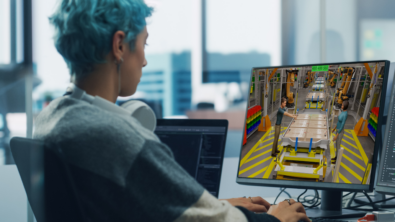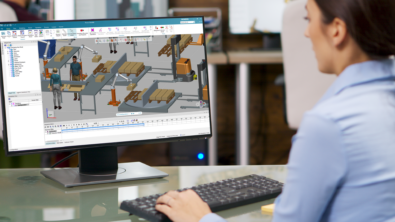Virtual Commissioning – A practical guide
By Shay Shomroni, Manufacturing Engineering Software, Siemens PLM Software
What is Virtual Commissioning?
Virtual commissioning is the practice of replicating the behavior of a physical manufacturing environment with a software system. The ultimate goal of the emulation is to provide an environment for the manufacturing automation controls engineer to validate their PLC (Programmable Logic Controller) ladder logic and HMI (Human Machine Interface) files prior to system debug in the manufacturing production environment.
What are the benefits of Virtual Commissioning?
Today’s highly automated and flexible manufacturing systems include sophisticated tooling, robots, transfer lines and other safety equipment and they are all controlled by programmable logic controller (PLC) programs. Virtual commissioning allows one to debug PLC code in a virtual environment before downloading it to real equipment. By simulating and validating automation equipment virtually, one can confirm that they will work as expected and significantly reduce system startup time. Manufacturers who have used virtual commissioning have reported reductions in engineering time by as much as 30 percent. The KUKA Systems do Brasil case study is a great example.
How does Virtual Commissioning work?
In a virtual commissioning process, engineers build a 3D virtual model of the system including all kinematic and static equipment, using simulation software. The 3D software is connected to the PLC and HMI, wherein the actual code runs. The virtual 3D system mimics the physical environment very accurately, so that the engineers can run all test and debugging procedures, just like they would in real life.
When to do Virtual Commissioning?
Virtual Commissioning is not limited for a specific industry or manufacturing branch. In-fact, any manufacturer can benefit from it. There are various documented examples of successful implementation of virtual commissioning in different industries. Whenever a company builds manufacturing systems or lines with a certain level of automation complexity, virtual commissioning should be considered. A typical virtual commissioning user will build manufacturing systems with one or more PLC and HMI devices, mechanical kinematic equipment, such as fixtures, conveyors and rails. It is also recommended to consider virtual commissioning when robots and NC machines are installed in the system.
How to select the right Virtual Commissioning Software?
First, manufacturers need to define their ultimate optimization goal. For systems with a wide range of mechanical tools and robots, a 3D-based Virtual Commissioning simulation is required. A very important factor to consider in selecting the appropriate software is its reliable collision detection support (clash avoidance). As in many cases, manufacturers author a large amount of 3D models. An important point to consider is the ability of the software to load large amounts of 3D data and laser scanned point cloud, if used.
In cases where one requires testing of the PLC code for material flow and logistics optimization, the virtual commissioning software must have good discrete event simulation capabilities, allowing for calculation of throughput and identification of production bottlenecks.
Second, good support of the control hardware is required. Best-in-class virtual commissioning tools support a wide variety of PLC and HMI brands. It is also very important to select a tool that allows switching from the emulated to the real environment as smoothly as possible.
Third, manufacturers should consider how the virtual commissioning software tool may integrate with their other engineering software, in the present and in the future. Connectivity to robotics simulation and offline programming systems may be very important, as well as the integration to product lifecycle management systems.
What to consider before starting Virtual Commissioning?
A successful virtual commissioning project is one that brings tangible savings in engineering effort and in physical commissioning time. To ensure great benefits from the first project, it is important to consider the following factors:
- Earlier collaboration –Mechanical, electrical (controls), and robotics engineers are used to collaborating on the shop floor during physical installation. Virtual commissioning requires collaboration in earlier phases of the project, before the physical equipment has even been installed. Besides changes in regular schedule and capacity allocation, it is important to ensure that the PLC and HMI code, robot programs and safety procedures are ready on time.
- Project Management – As it requires a combination of employees from different disciplines, software installation and data preparation, successful virtual commissioning should be treated as a strategic project. It is recommended to prepare all the stakeholders, avail their capacity and direct their attention to support the virtual commissioning activities. It is also recommended to assign an experienced project manager who’s well accepted by both electrical (controls) and mechanical departments.
- Teamwork – It is recommended to dedicate a physical laboratory for the virtual commissioning team. Teamwork is crucial for the success of a virtual commissioning project, as the interfaces between mechanical and electrical are validated. A lot of the preparation work can be done by geographically distributed teams. Along with that, it is highly recommended to perform the virtual commissioning project in a single location.
- Managerial umbrella – Virtual commissioning is becoming a standard practice, and many manufacturers are performing it on a regular basis. However, for the first one or two projects, it is highly recommended to get strong management buy-in and support, which may help to overcome obstacles. This is especially important when virtual commissioning is performed for or on behalf of an external customer.
- Software vendor support – Virtual commissioning promises a great opportunity for manufacturers. Selecting an experienced and reliable software vendor is important for the success of the project and is crucial for overcoming technological challenges.
How to measure the ROI of Virtual Commissioning?
Depending on the nature of the virtual commissioning implementation, ROI can be calculated. It is important to identify the expected values before committing to a project. Some examples for potential savings and ROI calculation methods are as follows:
- Reduction in total engineering time for office and shop floor. Measure the actual time vs. former projects.
- Reduction in the amount of shop floor errors. Count errors and compare to former projects.
- Reduction in the amount of tested safety failures. Measure the time it takes to approve start of production due to safety failures.
- Reduction in waste of prototype parts. Calculate the actual cost savings due to reduction in damage to prototype parts.
- Time to volume. Measure the reduction in time to production volume and its economic benefits.
Selecting your Virtual Commissioning software partner
Virtual Commissioning may bring huge benefit to your organization if deployed successfully, but it may also become an expensive experiment if things go wrong. The perfect virtual commissioning software vendor should be able to provide a great software tool with high-fidelity graphic performance, real-life signal-based simulation, reliable collision detection and strong discrete event simulation capabilities. It should also support a large variety of PLC and HMI brands and allow smooth transition between virtual and physical environments. On the other hand, make sure that your software provider has long-term and vast experience of proven success with virtual commissioning projects, and a reliable customer support structure.
Siemens PLM Software provides market leading virtual commissioning tools, such as Tecnomatix Process Simulate Commissioning and Tecnomatix Plant Simulation Commissioning.
To learn more about the success of Siemens Virtual Commissioning, see the following success stories:
To learn more about Siemens solutions, download our “PLM for Manufacturing” white paper about how to design and validate processes in a digital manufacturing environment.
![Reshaping the world with digital manufacturing [VIDEO]](https://blogs.sw.siemens.com/wp-content/uploads/sites/7/2024/07/Zvi_2024_2-395x222.png)

